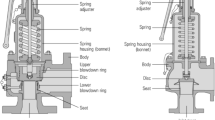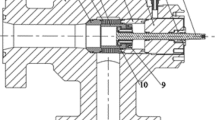Abstract
Pneumatic cryogenic control valves (PCCV) are designed to meet the special requirements for the large cryogenic helium refrigeration system. Polychlorotrifluoroethylene (PCTFE) is adopted as the flat seal material of the valve seat. The leakage rates and compressive strain of the PCTFE gasket with different sealing stress are tested at both room temperature (293 K) and liquid nitrogen temperature (77 K). After 300 open/close cycles, the experimental results show that the sealing properties of the PCTFE gasket are improved. The leakage rates are about 10−8 (293 K) and 10−4 (77 K) Pa m3 s−1 respectively. Finally, the effects of working pressure on sealing characteristics are discussed. The working pressure has little effect on compressive strain but it has a great influence on leakage rate. The leakage rate is linear with the working pressure of inlet at room temperature, but at liquid nitrogen temperature the leakage rate is linear with the square of the working pressure.
Similar content being viewed by others
References
Kalinin V, Tada E, Millet F, et al. ITER cryogenic system. Fusion Eng Des, 2006, 81: 2589–2595
Lebrun P. Large cryogenic Helium refrigeration system for the LHC. Geneva: European Laboratory for Particle Physics, LHC Project Report 629, 2003
Kimura N, Ohhata H, Okamura T, et al. Development of a variable quench pressure relief valve for superconducting magnet system. Cryogenic, 2011, 51: 465–469
Miller F K, Brisson J G. Development of a low-dissipation valve for use in a cold-cycle dilution refrigerator. Cryogenic, 1999, 39: 859–863
Weilert M, Hahn I, Barmatz M, et al. Progress on a small multi-cycling cryogenic fluid flow valve. Cryogenic, 2002, 41: 813–816
Chagovets V K, Rudavskii E Y, Taubenreuther K U, et al. A cold valve for superfluid helium. Physica B, 2000, 284–288: 2045–2046
Rae P J, Dattelbaum D M. The properties of poly (tetrafluoroethylene) (PTFE) in compression. Polymer, 2004, 45: 7615–7625
Bozet J L. Modeling of friction and wear for designing cryogenic valves. Tribol Int, 2001, 34: 207–215
Murari A, Vinante C, Monnari M. Compositon of PEEK and VESPEL®SP1 characteristics as vacuum seals for fusion applications. Vacuum, 2002, 65: 137–145
Arghavani J, Derenne M, Marchand L. Effect of surface characteristics on compressive stress and leakage rate in gasket flanged joints. Int J Adv Manuf Tech, 2003, 21: 713–732
Author information
Authors and Affiliations
Corresponding author
Rights and permissions
About this article
Cite this article
Zhang, N., Li, Q., Li, Q. et al. Seat tightness of pneumatic cryogenic control valve. Sci. China Technol. Sci. 56, 2066–2069 (2013). https://doi.org/10.1007/s11431-013-5272-8
Received:
Accepted:
Published:
Issue Date:
DOI: https://doi.org/10.1007/s11431-013-5272-8




